

The beginning of Book 9 finds the Achaeans demoralised after the tide of battle has turned against them with the intervention of Zeus.
Agamemnon stands before his commanders and declares Zeus to be harsh and cruel. He believes that Zeus’s intervention is a sign that the Achaean forces should return home in disgrace. There are echoes of Book 2 here where Agamemnon decided to test the resolve of his troops by suggesting they return home. This time, however, he means it. But Diomedes refuses to give into Agamemnon’s despair. Diomedes points out that Agamemnon questioned his courage (Book 4) before the battle, but he will not leave now. He urges Agamemnon to leave if he wishes, but speaks for the rest of the Achaean commanders, saying they will not leave. This declaration is supported by the acclamation of the rest of the Achaeans.
Nestor next stands to speak, saying that while Diomedes is correct, he must come to a conclusion. Nestor calls for the sentries to take their places and for meals to be served. He demands that Agamemnon lead by example and offer a feast for the senior chiefs. He believes that the Achaeans must restore their unity that night if they have any hope of winning. The sentries are dispatched and meals are cooked.
Meanwhile, Agamemnon and his senior chiefs retire to Agamemnon’s tent where Nestor begins by advising Agamemnon to make peace with Achilles. Agamemnon immediately acknowledges his own fault in the argument with Achilles, and is prepared to do much to reconcile. He will immediately offer treasures, including seven tripods, ten bars of gold, twenty cauldrons, a dozen stallions, and seven beautiful women. On top of that, he will return Briseis, whom he swears he has not slept with. Once Troy is vanquished, he promises Achilles will be allowed to take what spoils he wants and choose twenty Trojan women. Once they return home, Agamemnon will offer any one of his three daughters in marriage to Achilles, including a dowry. Nestor feels these gifts are more than just compensation for the wrong done to Achilles. He chooses old Phoenix, giant Ajax and Odysseus to visit Achilles and offer these terms.
Phoenix, Ajax and Odysseus visit Achilles’s tent where they find him playing a lyre while Patroclus listens. Achilles welcomes them warmly and shows them hospitality. They roast meat and eat. When they finish Odysseus outlines the dire situation they now face, since the Trojans now have them cornered at their ships. He points out that if they are defeated, Achilles will have no way to right the situation. Odysseus reminds Achilles of his father’s advice about quarrels: that greater renown is achieved by ending them. Odysseus then outlines the reparations Agamemnon is willing to give in order that their feud be ended. Odysseus pleads for Achilles to take pity on the Achaean men, and think of the glory he will gain by killing Hector.
But Achilles says he sees no advantage in the risks he is being asked to take, and feels that cowards and the brave all meet the same fate in the end. Achilles wishes to punish Agamemnon for taking Briseis when he had given so much to Agamemnon from the spoils of their looting in the region. Achilles says he loved Briseis. By losing her he lost her love and his own honour. He also points out that Agamemnon has managed to erect a defensive rampart around the ships, although he balances this observation by saying that Hector never dared attack beyond Troy’s walls while he was still fighting. Achilles says he plans to sail for home in the morning, along with his prizes and treasure. He tells Odysseus to go back to Agamemnon and tell him this. He says no gifts of value are enough to reconcile with Agamemnon. He will not marry Agamemnon’s daughter. No wealth is worth his life. He speaks of the two fates allotted him: one, a glorious short life; the other, a longer life without glory. He is now inclined to choose the latter. He finishes by saying he thinks the Trojan expedition doomed, and that the Achaean commanders should return home. Achilles turns to Phoenix and offers him passage home on his own ship.
Phoenix speaks of his bond with Achilles: how he took on the role of a father to Achilles when Achilles left home, inexperienced. He does not wish to be left behind. He talks of his relationship with his own father. His father had taken a mistress and his mother had encouraged him to sleep with the mistress to try to drive them apart. Phoenix did and incurred the wrath of his father, who put a curse on him, so that he may never have a son of his own. Phoenix was tempted to kill his father, but his hand was stayed by a god. He wanted to leave, but his cousins tried to stop him. Finally, he escaped his father’s household and he was taken in by King Pelleus, Achilles’s father, and he grew close to Achilles. Achilles became the son denied him by his father’s curse. Now, he argues that Achilles should relent and accept Agamemnon’s offer. By way of making his point, he decides to tell the company a tale.
Phoenix describes a war in which the Aetolians were defending their city against the Curetes. The war began when the God Artemis became angered she was made no offering by Oeneus, the king of the Aetolians, from his orchard. Artemis set a wild boar loose in his orchard which Meleager killed with the help of men from a dozen cities. Artemis declared the boar’s head a prize for whichever city could defeat the Aetolians for it. This begins the Curetes’s war against the Aetolians. The next part of the story is vague in Homer. He must have assumed his audience knew it well enough. But we learn in Homer’s version that Meleager has killed an uncle, brother to his mother, but it is unclear why (more details are given about this story in the next column). Althaea, his mother, cursed Meleager. Meleager, as a result, withdrew to his wife’s bedroom. His withdrawal from the fight is similar to Achilles’s own withdrawal. The tide of the battle turned against the Aetolians and Meleager was begged to return to the fight. His mother was one of those who petitioned him. Meleager does rejoin the fight, but only after part of the city is burned, women raped and the city plundered. He saves the city, but it is too late to enjoy the benefits of the victory. This is the tale Phoenix tells Achilles’s as a warning against his own intransigence.
Achilles’s acknowledges his old tie to Phoenix but says his association with Agamemnon will only degrade him. He asks again that Phoenix leave with him in the morning.
At that, Ajax suggests that the envoys return to the Achaeans to report the outcome of the meeting. But he also says that Achilles’s intransigence is unnatural: that he should have compassion and perspective and accept Agamemnon’s compensation. Achilles says he will only fight when Hector reaches his own ships.
The envoys return to Agamemnon. They report Achilles’s refusal to reconcile and his plan to sail home. Diomedes is critical of Agamemnon. He suggests that Agamemnon has only inflamed Achilles’s pride by making this offer. He suggests that for the sake of morale, Agamemnon should personally lead the Greek forces against the Trojans the following day.
Book 9 of The Iliad focuses upon Achilles and his relationships with Agamemnon and Phoenix. Both are essentially father figures to Achilles. As his King, Agamemnon has the power to confer glory and wealth upon Achilles, but he has overstepped the bounds by taking Briseis from Achilles in Book 1. Phoenix’s story tells us how Phoenix substituted Achilles as his son for the son he could never have, due to his father’s curse upon him. Apart from the story – that Achilles rejects Agamemnon’s offer of reconciliation in Book 9 – these two father figures help further characterise the anger and loss of status Achilles feels.
There is a disparity between the wrong Achilles feels – his qualitative measure of Agamemnon’s action, if you will – versus the quantitative strategy Agamemnon adopts to end the quarrel: Agamemnon feels that by returning Briseis and offering a host of other prizes too, Achilles’s wrath should be assuaged. This is the point of the long list of rewards Agamemnon outlines, (in the summary) which is repeated in the text by Odysseus when he presents Agamemnon’s terms to Achilles.
Phoenix argues that Achilles should accept Agamemnon’s offer. Achilles rejects this, so essentially defies two fathers. Ajax also weighs in on the side of Agamemnon. In Ajax’s argument we sense the difference between our modern values and those of Ancient Greek Society:
Ajax’s example may be exaggerated to make his point against Achilles, since Achilles can have Briseis returned to him, untouched by Agamemnon. It clearly makes a definitive quantitative argument against Achilles, but Achilles’s rage is based upon a more abstract argument about pride, love and honour. After all, he points out, the entire war is predicated upon the issue of honour, since it is fought for the return of Helen to Menelaus. If so many men can die for the sake of Menelaus’s honour, why can’t Achilles protect his own:
The detail of Helen’s “loose and lustrous hair” is a wonderful evocation of Helen’s infidelity. Achilles’s feelings for Briseis, he argues, are at least as noble as those of Paris:
Achilles conflates the principles of love and honour in this statement, neither of which can be reconciled by the quantitative rewards offered by Agamemnon, in his eyes. This goes to the heart of Achilles’s thinking about his own place in the world. He has been told he can have either one of two fates (Book 9 lines 497 – 505). The first is a short life full of glory. But if he chooses a simpler life with no glory he will live long. In Achilles’s mind, glory and honour have been taken from him, so it is senseless to risk his life:
This, it seems, is a large part of Achilles’s intransigence. He sees his choice as binary, and one of his two options has been circumvented by Agamemnon’s action. Without glory and honour, a long life without action is a rational choice in Achilles’s mind, that no further reward can tempt him from.
The story Phoenix tells about Meleager is an attempt to influence Achilles to relent. His association of Meleager with Achilles in his tale is transparent. The story was well known to Homer’s audience as one of the tales about great heroes in the period before the events of the Trojan War. This may explain why some of the events seem unclear or ambiguous in Homer’s retelling of the tale, compared to another later version by Ovid, who compiled various elements of the story in Metomorphoses. Here are a few aspects of the story that are missing from Homer’s account, are unclear in their detail, or different from Ovid’s account:
The story of the Calydonian boar begins with Artemis who sends the boar against Oeneus because he has offended her by leaving her name out of the offerings made to the gods. The boar is so huge and dangerous that no single person is able to kill it. Homer tells us that Meleager musters “hunters from a dozen cities.” Ovid tells us specific names, a veritable roll call of the great heroes of the generation preceding the Trojan War. Included in this group of hunters is Peleus, the father of Achilles, as well as Nestor, who is old by the time of the Trojan War. The boar kills several hunters. Nestor escapes with his life by using his spear as a vaulting stick to leap into a tree. Atalanta wounds the boar after several of the male hunters fail to find their mark. Meleager kills the boar and offers Atalanta its hide as a prize. When his uncles abuse him for giving the prize to a woman and attempt to take it from her, Meleager kills them.
It is here that Homer’s and Ovid’s versions diverge. Homer’s version becomes a tale about a war over who can claim the hide of the Calydonian Boar and Meleager’s refusal to fight – much like Achilles – because of his mother’s curses against him for killing her brothers.
In Ovid’s version, the story becomes a tale about revenge, in which Meleager’s mother uses her knowledge of the power of the log associated with Meleager’s life, to kill him so that he will die without wounds or honour.
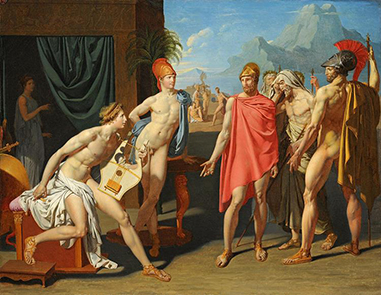
This painting by Ingres was produced for the 1801 Prix de Rome competition in Paris. The theme for the competition was the progress to war. Ingres’s oil painting portrays the moment that Achilles is visited by Odysseus, Ajax and Phoenix, hoping to persuade him to accept Agamemnon’s offer to reconcile. Achilles is in red at the centre of the painting. The lyre, which is being played by Achilles when the envoys arrive, is pictured to the left. The work is influenced by Jacques-Louis David, and was meant to demonstrate Ingres’s skill at portraying the human figure in the classical style.
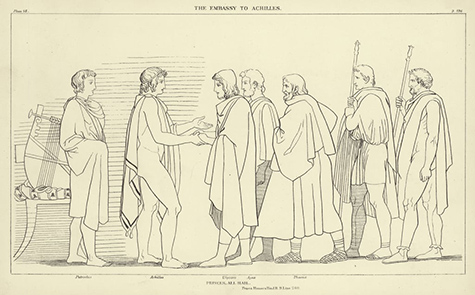
John Flaxman was a neoclassical sculptor and draughtsman. This image is arranged like a bas-relief, showing its subjects in a linear arrangement from the side. From left to right appear Patroclus, who has been listening to Achilles play the lyre which now sits behind him. Next is Achilles who graciously accepts Odysseus. Following Odysseus is Ajax and then Phoenix, followed by two unnamed envoys. The image is classical in its formality, but it accurately captures the hospitable and friendly welcome Achilles gives his old friends. It is only later, when Achilles has heard Agamemnon’s offer, that Achilles becomes more animated and angry.
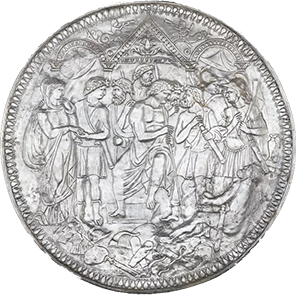
This Roman silver and gold plate was found in 1656. It's subject matter is now thought to be the embassy of Achilles from Book 9 of The Iliad. However, this is not certain. When first found the image was thought to be a scene from Roman history, with Scipio Africanus. It was later believed to be a representation of Achilles’s reconciliation with Agamemnon in Book 19. But given the expression of Agamemnon, thought to be the figure on the right of Achilles, who is seated in the centre of the image, this turned thinking towards the earlier scene in which Achilles is asked to reconcile in Book 9. This kind of debate lays bare the problem of interpreting some works from the classical period, found with little context. Of course, if this is a representation of the embassy to Achilles, the image strays from the text by having Agamemnon present. I suspect that in the future there will be other theories about what the image on this silver plate represents.
This third century Roman sarcophagus displays all the elements that Rubens would later use for his own painting, below. The depiction of the boar and Meleager would be faithfully reproduced by Rubens, but this earlier image gives greater importance to Atalanta who, according to Ovid, was the first to wound the boar with her arrows after male warriors failed. In this image she stands to the right of Meleager in this bas-relief, and just behind or next to the boar.
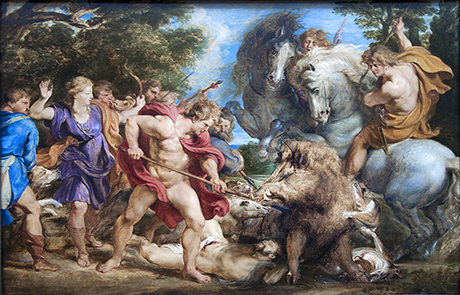
Peter Paul Rubens drew his inspiration for this scene from Roman sarcophaguses, like the one above. The painting was meant to be an allusion for well-versed viewers, knowledgeable of its source. The figure in red, spearing the boar, is Meleager, delivering the fatal blow. The woman dressed in purple to Meleager’s left is Atalanta. She is holding the bow that delivered the first wounds to the boar. Ovid tells us that several hunters died while battling the boar. In this image Ancaeus lies dead at the boar’s feet, along with one of the hunting hounds. The positioning of Meleager and the figures on horseback seems to reduce the significance of Atalanta’s role in the final killing of the boar by separating her from the immediate action.
Of course, Homer’s version of the story gives few details about the battle and does not mention Atalanta at all.
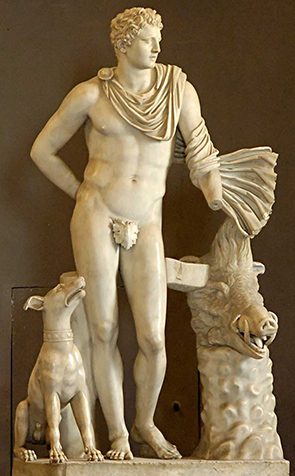
This Roman copy of an original Greek sculpture is a typical representation of the Greek Classical period. Meleager stands contrapposto, accompanied by his hunting dog, with one hand (now missing) presumably resting on the boar’s head. While skilful and aesthetically pleasing, the sculpture does not capture the drama of the hunt as described by Ovid. Rather, it represents the assuredness of the hunter, removed from the context of the subsequent conflict with his uncles and mother.
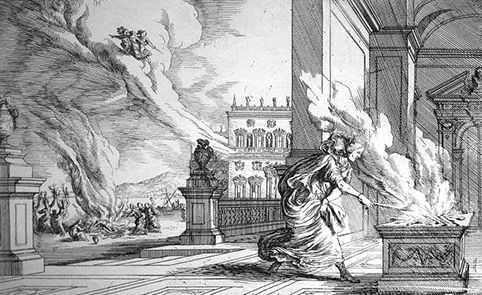
Althaea’s revenge against her son, Meleager, for his killing of her brothers Plexippus and Toxeus, is perhaps one of the most striking things about the story of the Calydonian Boar: a detail that Homer omits. Ovid writes:
Althaea determines to kill her son in a way which will cause no bloodshed and allow no glory. In Ovid’s version of the story, Althaea is told by the Three Fates after childbirth that her son, Meleager, will live only as long as a log in the fire takes to burn. Hoping to protect her son, she removes the log from the fire and buries it. But after Meleager has killed her brothers, it is the log which is the instrument by which Althaea seeks to kill her son.
This image by Baur represents Althaea burning the log while Meleager simultaneously perishes outside. Ovid portrays the scene in this way:
Comments
No one has commented yet. Be the first!